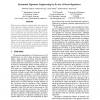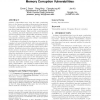17 search results - page 3 / 4 » Automatic detection of fault attack and countermeasures |
ACSAC
2008
IEEE
14 years 1 months ago
2008
IEEE
Most intrusion detection systems apply the misuse detection approach. Misuse detection compares recorded audit data with predefined patterns denoted as signatures. A signature is ...
ICSE
2008
IEEE-ACM
14 years 7 months ago
2008
IEEE-ACM
Modern worms can spread so quickly that any countermeasure based on human reaction might not be fast enough. Recent research has focused on devising algorithms to automatically pr...
DSN
2009
IEEE
13 years 4 months ago
2009
IEEE
Preserving the availability and integrity of networked computing systems in the face of fast-spreading intrusions requires advances not only in detection algorithms, but also in a...
CCS
2007
ACM
14 years 1 months ago
2007
ACM
Software vulnerabilities have been the main contributing factor to the Internet security problems such as fast spreading worms. Among these software vulnerabilities, memory corrup...
TSE
2008
13 years 7 months ago
2008
Web applications are widely adopted and their correct functioning is mission critical for many businesses. At the same time, Web applications tend to be error prone and implementat...


